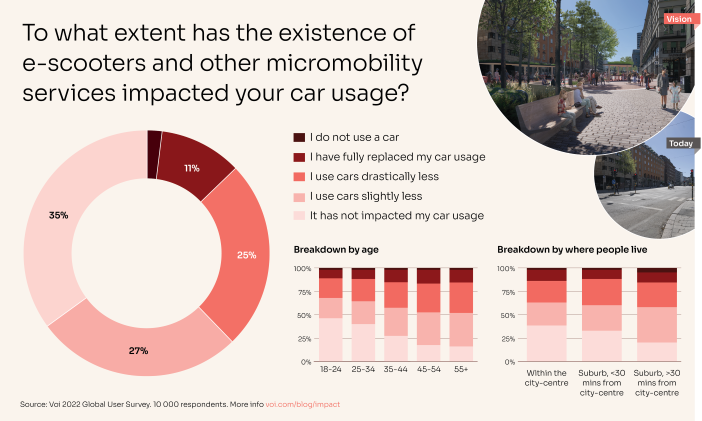More people are combining shared micromobility with public transport in cities across Europe and leaving their cars at home, according to a survey by Sweden’s Voi Technology.
The micromobility company’s annual user survey, which polls 10,000 riders across the European continent, shows that 36% of e-scooter riders say they have drastically or fully replaced their car use because of the availability of micromobility, including e-scooters.
Every year, Voi conducts an international user survey to understand rider behaviour, including what kind of transport modes are replaced by an e-scooter and reasons for riding. This year’s survey includes a new question to better understand how the existence of e-scooters and other micromobility services has impacted users’ car use over time.
Voi says that these results indicate that micromobility services may have a bigger impact on car use than previously thought, as more people find shared mobility services combined with public transport to be a viable alternative to the car. Voi is calling for more research on how the existence of micromobility services impacts users’ cars use over time.
As shared mobility services of e-scooters and e-bikes have expanded across Europe, riders have found more ways to use the electric vehicles and are increasingly building them into their everyday routines. One consequence is that the number of people using the e-scooters for fun – or as an experience – has fallen. Last year, over 40% of riders said one of their primary purposes for riding an e-scooter was for fun, with no particular destination. However, this has since fallen to 30% with more people saying they use e-scooters for travelling to socialising events (59%) and commuting to work or education (48%). Voi says this indicates that as people become more familiar with micromobility, they incorporate it into their regular routes and use it in combination with public transport.

Around 25% of riders are solely using e-scooters for their journeys, whilst more than 55% of riders say that they typically are combining e-scooter rides with public transport, up from 47% last year. In this way, micromobility is helping to solve the first/last mile challenge of public transport in cities across Europe.
E-scooters are being adopted across Europe by riders of all ages. Close to half of the respondents aged 45+ say they have reduced their car use significantly since adopting shared micromobility. The take-up of e-scooters by older age groups shows that micromobility is suitable for all ages, giving people choices where previously they would have taken a car.
There are also signs that e-scooter use is particularly lowering car usage in the suburbs. Over 60% of riders who live within a 30-minute public transport ride of the city centre have reduced their car usage because of micromobility services. On average, 14% of Voi rides replace a car trip with an e-scooter ride.
“We’re starting to see a significant impact with more people using e-scooters alongside public transport and people of all ages find a flexible alternative to car trips, or even ditching the car completely,” says Fredrik Hjelm, co-founder and CEO of Voi. “Micromobility services such as Voi are contributing to a reduction in air pollution and harmful emissions, making our cities happier places to live. Even with over 100 million rides and 100 cities under our belts, we’ve only scratched the surface of what is possible with shared micromobility and there are even greater benefits for Europe’s cities, their air and quality of life as we continue on this journey.”
Images: Voi





